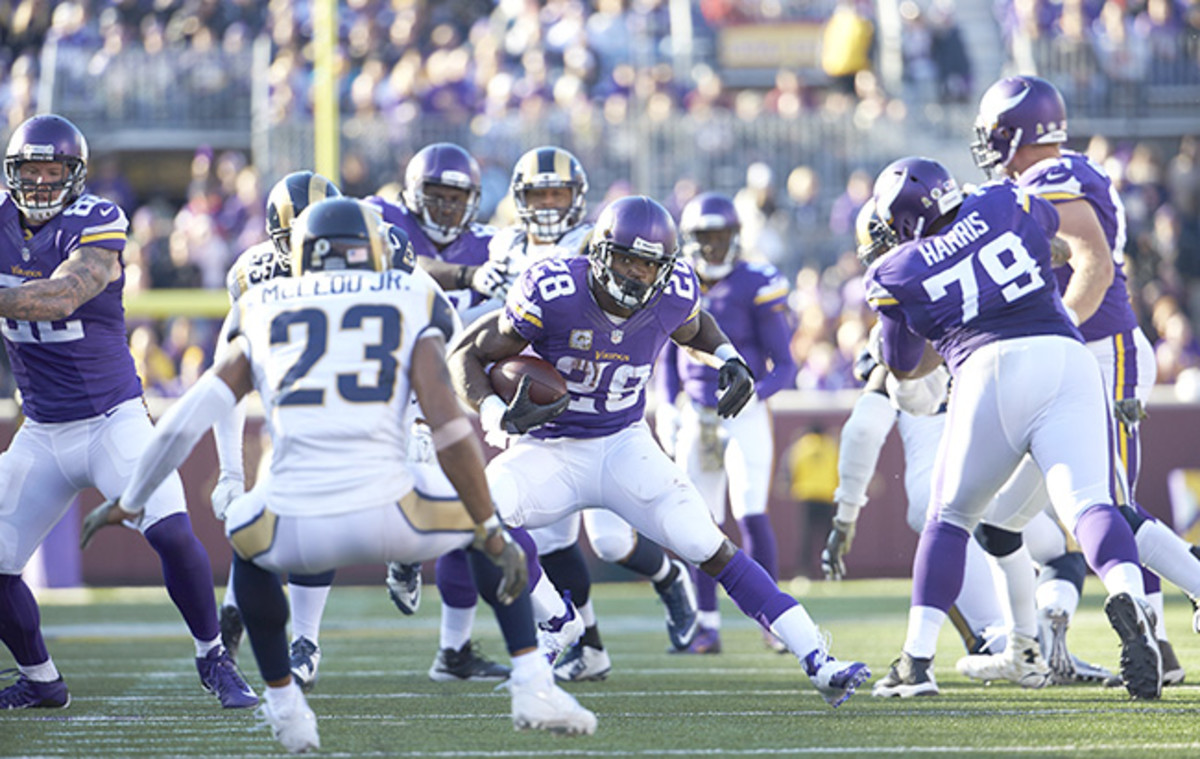Scouting Minnesota: Peterson Is Football’s Best Pure Runner

1. Adrian Peterson is still the best pure runner in football. True, far too many of his runs last season failed to get back to the line of scrimmage, but that’s what happens when you put a superstar running back behind three backup linemen and with a quarterback who doesn’t threaten the field vertically. What makes Peterson special is his violent downhill burst paired with explosive lateral agility. No player moves left and right in confined spaces with such balance and force.

2. The addition of right guard Alex Boone could prove huge. Boone, 29, is coming off a down year in San Francisco, but he’s still an upgrade over the heavy-legged Michael Harris. Plus, he’s playing alongside center John Sullivan, who is healthy after missing last season with a back injury. With these two, the Vikings now have interior linemen who can pull-block, which helps expand a rushing attack that’s been confined to staying between the tackles.
3. The discussion about Teddy Bridgewater will take on an uglier tone this season. Fans have started to notice that Bridgewater doesn’t attack the intermediate and deep levels. He’s very cautious. That’s because he doesn’t have great arm strength. At some point that becomes a real problem in a Norv Turner system that’s predicated on attacking downfield.
4. It’ll be very interesting to see what happens with wideout Stefon Diggs in Year Two. In his first four games, Diggs averaged six catches and 105 yards an outing. In his last nine games he averaged three catches and 33 yards an outing. Diggs has outstanding short-area quickness, which shows most on receiver screens and dig routes. The guess here is he’ll prosper—though that’s not guaranteed.
• FANTASY RANKINGS:QUARTERBACKS | RUNNING BACKS | WIDE RECEIVERS | TIGHT ENDS
5. Matt Kalil has tens of millions of dollars riding on this season. The Vikings picked up the fifth-year option on his rookie deal, paying him $11 million in 2016. After that, it’s decision time. Kalil has been average at best, and he’s achieved his averageness not through steady, mediocre play, but rather, through highs and lows. Teams don’t like needing a left tackle, which is why so many of them get overpaid. If Kalil has a decent (and only decent) season, some team will sign him to a rich long-term deal. But if he flounders, like he too often has, then what?
6. The Vikings have the fundamentally soundest defense in the NFC. They tackle well, maintain gap discipline and rarely blow coverages. Those are signs of good coaching. Another sign: Virtually all of this unit’s high-drafted athletes have panned out.
7. You have to be a willing and sturdy tackler to play in Mike Zimmer’s secondary. Zimmer’s scheme is heavy in two-high and split-safety coverages, which means the Vikings defend the run with only seven men in the box. From there, these defenders are often taught to play gaps inside out, in order to make ballcarriers spill towards the sideline. In Quarters, Minnesota’s biggest staple coverage, the safeties are responsible for the furthest outside rushing lane. In Cover 2 (another staple), the cornerbacks are the widest designated run defenders. Watch Minnesota’ secondary. You’ll notice that everyone tackles. That’s not a coincidence.
8. That secondary is also the deepest in the NFC. Along those lines, another thing Zimmer does: He drafts cornerbacks high and develops them from bench roles in Years One and Two. Last season, the Vikings took Trae Waynes in the first round. He was impressive as a fill-in starter, but he still entered training camp this year behind soon-to-be 38-year-old Terence Newman. (Newman has played seven years for Zimmer, dating back to their days in Dallas and Cincinnati.) This year’s high-drafted corner was Mackensie Alexander (second round). He’s a consummate nickel slot player, but don’t be surprised if he rides the bench until 2018. Incumbent slot man Captain Munnerlyn has a good understanding of this scheme’s coverage rotations and matchup-man concepts inside.
9. Nose shade tackle Linval Joseph is the most underrated run defender in football. He has an outstanding blend of lateral movement and strength, mixed with an ability to locate the ball in traffic.
10. Anthony Barr and Eric Kendricks are exactly what you want in a nickel linebacking tandem. Barr is big and physical yet nimble. He stacks and sheds blocks with force and is adroit at blitzing, both on design and improvisation. These traits also help him create turnovers. Kendricks is more finesse—and that’s a good thing. He’s generally the free defender in Minnesota’s man coverage concepts, serving underneath as the QB spy or inside passing lane jumper. Both of these men are alert and athletic enough to disguise their intentions and change directions after the snap. That’s vital for filling the double-A-gap blitz responsibilities in Zimmer’s system.
Question or comment? Email us at talkback@themmqb.com
